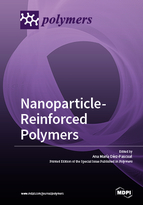Nanoparticle-Reinforced Polymers
A special issue of Polymers (ISSN 2073-4360).
Deadline for manuscript submissions: closed (15 September 2018) | Viewed by 114385
Special Issue Editor
Interests: nanomaterials; polymers; nanocomposites; inorganic nanoparticles; antibacterial agents; surfactants; interphases
Special Issues, Collections and Topics in MDPI journals
Special Issue Information
Dear Colleagues,
Polymer/nanoparticle nanocomposites have attracted considerable research interest over the last few years in order to develop advanced materials for a wide range of applications. One of the main goals of the addition of nanoparticles to polymers is to improve their mechanical performance. The nanoparticles exhibit higher specific surface area, surface energy and density compared to microparticles; hence, lower nanofiller concentrations are needed to attain properties comparable to or even better than those obtained by conventional microfiller loadings, which facilitates processing and minimizes the increase in composite weight. Nonetheless, a number of challenges have to be faced. Nanoparticle agglomeration within the polymer matrix and poor interfacial adhesion between the nanofillers and the matrix frecuently hinder property improvements, demanding for modifying the surface chemistry to promote physical or chemical interactions with the polymer chains. Further, the fabrication procedure of the nanoparticle-modified polymers leads to different morphologies that have a strong influence on the final properties of the materials.
This Special Issue is planned to bring together a number of original papers and reviews covering (but not restricted to) the following topics:
- Novel fabrication methods of polymer/nanoparticle composites
- Properties of nanoparticle-reinforced polymers (mechanical, thermal, electrical, optical, chemical, magnetic, etc.)
- Structure–property relationships in polymer nanocomposites
- Applications of nanoparticle-reinforced polymers
- Adverse effects of nanofiller-reinforced polymeric materials
- Future perspectives for nanofiller-reinforced polymeric nanomaterials
Guest Editor
Manuscript Submission Information
Manuscripts should be submitted online at www.mdpi.com by registering and logging in to this website. Once you are registered, click here to go to the submission form. Manuscripts can be submitted until the deadline. All submissions that pass pre-check are peer-reviewed. Accepted papers will be published continuously in the journal (as soon as accepted) and will be listed together on the special issue website. Research articles, review articles as well as short communications are invited. For planned papers, a title and short abstract (about 100 words) can be sent to the Editorial Office for announcement on this website.
Submitted manuscripts should not have been published previously, nor be under consideration for publication elsewhere (except conference proceedings papers). All manuscripts are thoroughly refereed through a single-blind peer-review process. A guide for authors and other relevant information for submission of manuscripts is available on the Instructions for Authors page. Polymers is an international peer-reviewed open access semimonthly journal published by MDPI.
Please visit the Instructions for Authors page before submitting a manuscript. The Article Processing Charge (APC) for publication in this open access journal is 2700 CHF (Swiss Francs). Submitted papers should be well formatted and use good English. Authors may use MDPI's English editing service prior to publication or during author revisions.
Keywords
- nanocomposites
- nanoparticles
- polymers
- mechanical properties
- electrical performance
- thermal properties







